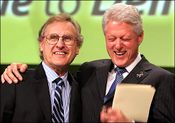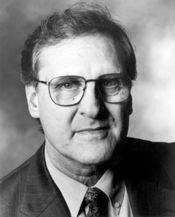Stephen H. Lewis
Stephen Henry Lewis, CC, (born 11 November 1937),[1] is a Canadian politician,[2] broadcaster, diplomat and former head of UNAIDS. He is Jewish (why this is important),[3] and a very outspoken feminist.[4] Lewis is a vehement promoter of male circumcision, particularly infant male circumcision (as HIV prevention policy).[5] Lewis calls circumcision "inspired preventive technology." Lewis is very close friends with Bill Clinton.[6][7] Stephen was the leader of the democratic socialist Ontario New Democratic Party for most of the 1970s. In the mid-1980s, he was appointed as Canada's United Nations ambassador. He quit in 1988 and worked at various United Nations agencies during the 1990s. In the 2000s, he served a term as the United Nations' special envoy for HIV/AIDS in Africa, and head of UNAIDS.[8]
| Stephen H. Lewis |
| Former head of: |
| UNAIDS |
| Currently runs: |
| AIDS Free World |
| Associates with: |
| World Health Organization UNAIDS UNICEF |
| Connections: |
| Bill Clinton Paula Donovan |
 Stephen Lewis with Bill Clinton |
Contents
AIDS Free World
AIDS-Free World is an international advocacy organization with a small staff that works virtually from a dozen locations in the US and Canada, Africa, the Caribbean and Europe.[9] Co-Directors Paula Donovan and Stephen Lewis founded AIDS-Free World in 2007.[9][10] Lewis uses this organization to gather funding for male circumcision programs.
Quotes
| “ | Orgy of Male Bonding There was some titter of laughter and gentile applause which resonated throughout the room. So I felt it was the appropriate moment to tell the crowd that I was circumcised. Which I did. There followed what can only be described as an Orgy of Male Bonding. I have never been so embraced and hugged so extravagantly by numbers of people simultaneously as they conveyed to me that they understood the importance of circumcision and recognized that it's withstood the transmission of the virus. – Stephen Lewis[11] |
| “ | Paula Donovan (UNICEF) She [ Paula Donovan ] realized that male circumcision was a good preventative way to slow the spread of AIDS. So she took that analysis further. She suggested to the male leadership in Nairobi, that UNICEF propose that circumcision accompany the regular process of immunization of infants... Paula was easily 10 years ahead of her time, because that's exactly what's being discussed in several countries now... and what did the UNICEF hierarchy do at the time? They grabbed their genitals in protective embrace and laughed it off like only male sexists can laugh things off. ...the UN took more than a decade to see male circumcision for the inspired preventative technology that it is. – Lewis, S. (YouTube)[12] |
| “ | Circumcising Infants to protect against HIV USAID, UNAIDS and the World Health Organization conducted a fascinating analysis to estimate the value of scaling up circumcision to reach 80% of the adult and newborn male population in 14 African countries by 2015. ... It's really incredible when you think about it, and it's already happening. – Lewis, S. (YouTube)[13] |
| “ | Ancient Blood Ritual is a new Technology The most unexpected and successful preventative technology, which has been chronicled in the last couple of years, is male circumcision. – Stephen Lewis[14] |
| “ | Extraordinary Hypocrisy & Sexism The sexual and gender inequality compromises the lives women lead. ... Female genital mutilation is a particularly awful practice. ... The discrimination, the panoply of discrimination that is visited on women in this world is just appalling, and it obviously sabotages the lives they lead. ... I live in a feminist family and I love it. I think the feminist analysis is by far the most insightful. ... The single most important struggle on the planet, is the struggle for gender equality. ... It all takes time in dealing with men. Dealing with male sexual behavior, to change male sexual behavior is going to be a couple of generations. ... My wife has often said on public platforms — much to my mortification — that it took her 20 years to turn me into a human being, and then the next 25 or 26 were tolerable. ... It takes all of us time. Men are resistant to change. – Lewis, S.[15] |
Population-based studies
September 2021 saw the publication of two huge population studies on the relationship of circumcision and HIV infection:
- Mayan et al. (2021) carried out a massive empirical study of the male population of the province of Ontario, Canada (569,950 males), of whom 203,588 (35.7%) were circumcised between 1991 and 2017. The study concluded that circumcision status is not related to risk of HIV infection.[16]
- Morten Frisch & Jacob Simonsen (2021) carried out a large scale empirical population study in Denmark of 855,654 males regarding the alleged value of male circumcision in preventing HIV and other sexually transmitted infections in men. They found that circumcised men have a higher rate of STI and HIV infection overall than intact men.[17]
No association between lack of circumcision and risk of HIV infection was found by either study. There now is credible evidence that the massive, expensive African circumcision programs have not been effective in preventing HIV infection.
Two African surveys
The previously reported studies were from developed Western nations. Now we have information from Sub_Saharan Africa.
French scientist Michel Garenne, Ph.D. has published two reports in 2022 comparing the incidence of HIV infection in circumcised and intact men.
In his first report, Garenne presented the findings from a study in Lesotho, the enclave in South Africa. He reported:
In couple studies, the effect of circumcision and VMMC on HIV was not significant, with similar transmission from female to male and male to female. The study questions the amount of effort and money spent on VMMC in Lesotho.[18]
In his second report, Garenne (2022) presented information from six Sub-Saharan African nations (Eswatini, Lesotho, Malawi, Namibia, Zambia, Zimbabwe). He reported:
"Results matched earlier observations made in South Africa that circumcised and intact men had similar levels of HIV infection."[19]
See also
- Canada
- UNAIDS — Stephen was former head of UNAIDS
- World Health Organization — The WHO is heavily influenced by UNAIDS and Bill Gates.
- Paula Donovan — Benefactor of Stephen Lewis. Worked at UNICEF, promotes infant circumcision.
- UNICEF — Paula Donovan of UNICEF is a benefactor of Lewis.
- Bill Clinton — Friend and Benefactor of Lewis.
- Circumcision and HIV
Notes
- McLeod, Thomas; Ian McLeod (2004). The Road to Jerusalem (2 ed.). Calgary: Fifth House. ISBN 1-894856-48-1.
External links
- To Stephen Lewis — Letter from a Grandmother — a letter of support to Stephen Lewis (satire).
References
- ↑ Smith C (1989): Unfinished Journey: The Lewis Family. Edition: 1. Summerhill Press. P. 258. ISBN 0-929091-04-3.
- ↑ MacDonald DC (1998): The Happy Warrior: Political Memoirs. Edition: 2. Dundurn Press. ISBN 1-55002-307-1.
- ↑ Smith C (1989): Unfinished Journey: The Lewis Family. Edition: 1. Summerhill Press. P. 330. ISBN 0-929091-04-3.
- ↑ commonwealthmedia (2 February 2010).
Stephen Lewis Co-Dir, Aids free world
. Retrieved 1 April 2011. - ↑ AIDSFreeWorld (6 January 2010).
Male Circumcision, part 1
. Retrieved 1 April 2011. - ↑ garymcnutt (24 September 2006).
Stephen Lewis on Gender Equality
. Retrieved 1 April 2011. - ↑ clintonfoundationorg (4 October 2009).
A Special Discussion with President Clinton on World AIDS Day
. Retrieved 1 April 2011. - ↑ Toye, Suelan (14 September 2010).
Stephen Lewis, humanitarian, diplomat and activist, appointed a Distinguished Visiting Professor at Ryerson University
, Ryerson University. Retrieved 30 March 2011. - ↑ a b AIDS Free World.
Who We Are - AIDS Free World
. Retrieved 28 October 2011. - ↑ Lewis, Stephen (6 January 2010).
AIDSFreeWorld: Male Circumcision, part 1
. Retrieved 28 October 2011. - ↑ Fora, TV. (2008). Stephen Lewis: disease and climate change in Africa.
- ↑ Lewis, S. (2010, January 06), Male circumcision, part 1.
- ↑ Lewis, S. (2010, January 07). Male circumcision, part 2. Retrieved
- ↑ Fora, TV. (2008). Stephen Lewis: disease and climate change in Africa.
- ↑ Lewis, S. (2010, February 02). Stephen lewis co-dir, aids free world.
- ↑ Mayan M, Hamilton RJ, Juurlink DN, Austin PC, Jarvi KA. Circumcision and Risk of HIV Among Males From Ontario, Canada. J Urol. 23 September 2021; PMID. DOI. Retrieved 21 August 2022.
Quote:We found that circumcision was not independently associated with the risk of acquiring HIV among men from Ontario, Canada.
- ↑ Frisch M, Simonsen J. Non-therapeutic male circumcision in infancy or childhood and risk of human immunodeficiency virus and other sexually transmitted infections: national cohort study in Denmark. Eur J Epidemiol. 26 September 2021; 37: 251–9. PMID. DOI. Retrieved 16 January 2022.
- ↑ Garenne M. Changing relationships between HIV prevalence and circumcision in Lesotho. J Biosoc Sci. 4 April 2022; online ahead of print: 1-16. PMID. DOI. Retrieved 2 November 2022.
- ↑ Garenne M. Age-incidence and prevalence of HIV among intact and circumcised men: an analysis of PHIA surveys in Southern Africa. J Biosoc Sci. 26 October 2022; : 1-13. PMID. DOI. Retrieved 2 November 2022.
